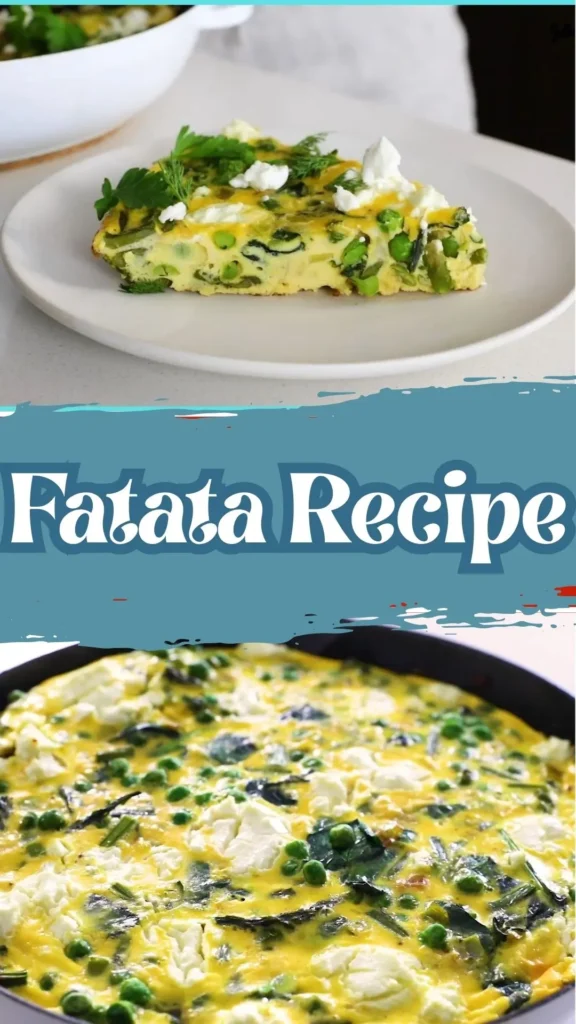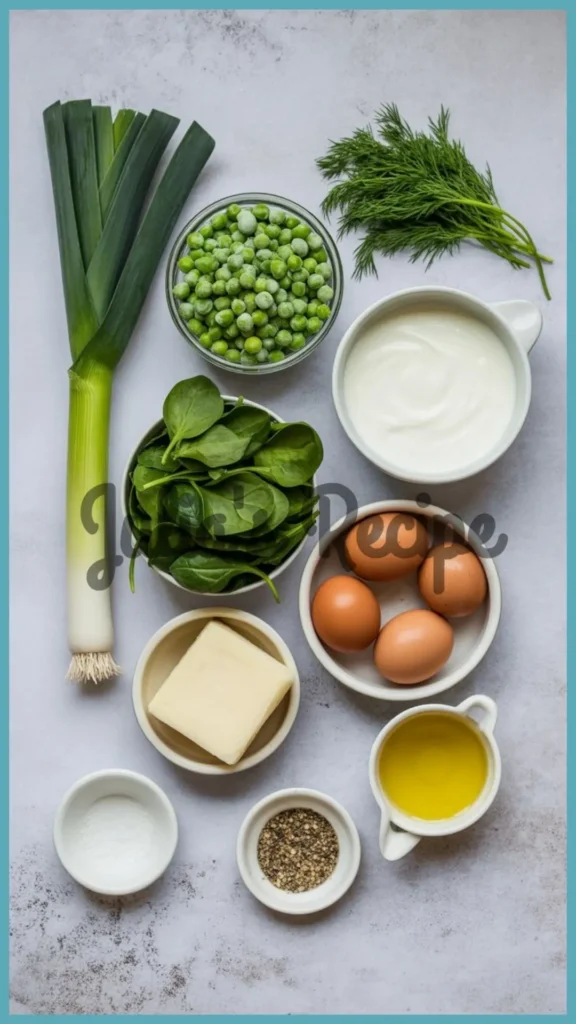The Best Fluffy Pancakes recipe you will fall in love with. Full of tips and tricks to help you make the best pancakes.
Fatata Recipe
There’s something undeniably satisfying about a dish that’s equal parts beautiful, nutritious, and effortless. Today, we’re diving into a fresh and vibrant Fatata recipe-a frittata loaded with spring vegetables and full of color and flavor. Whether you’re new to frittatas or already a fan, this version might just become your go-to.

What makes this dish a keeper is its incredible flexibility. You can enjoy it for breakfast, brunch, lunch, or dinner-hot or cold. It’s also a fantastic way to use up your favorite seasonal veggies from the farmers market, making it both practical and sustainable.
Perfect for serving guests during spring gatherings or meal prepping for the week ahead, this frittata brings bright flavors, creamy textures, and a hearty, wholesome feel to the table.
Why You’ll Love Fatata
First off, this Fatata recipe is all about simplicity. With just a bit of chopping and one pan, you’ll have a picture-perfect, oven-baked frittata that’s light, fluffy, and packed with veggies. It’s approachable for beginners yet satisfying for seasoned home cooks.
What’s more, it’s easy to customize. Don’t have goat cheese? Swap it for cheddar or feta-or skip the cheese altogether. Want to use other vegetables? Go right ahead. This dish thrives on creativity and flexibility.
Lastly, it stores like a dream. Whether you’re feeding a crowd or saving leftovers for the week, this recipe will give you eight portions of flavorful nourishment that reheat beautifully.
Ingredients Required for Fatata Recipe
Before you start, make sure you have all the following ingredients listed below for this Fatata Recipe
- 1 leek (white and light green parts), cleaned and sliced
- 1 cup frozen peas
- 1 packed cup baby spinach
- 10 large eggs
- ½ cup yogurt (regular or dairy-free)
- 2–3 tbsp olive or avocado oil
- 3 oz soft goat cheese (or substitute cheese of your choice)
- Salt and pepper, to taste
- Fresh herbs (parsley, dill) for garnish

Kitchen Equipment Needed
- Large mixing bowl
- 10-inch oven-safe skillet
- Whisk
- Knife and cutting board
- Colander (for cleaning leeks)
- Spoon or spatula
- Oven mitts
Prep Time: 15 minutes
Cook Time: 20 minutes
How To Make Fatata
Just follow these easy steps to make your own Fatata at home
1. Chop vegetables: Trim and slice asparagus into ½-inch pieces. Slice and thoroughly clean the leek.
2. Whisk eggs: In a large bowl, crack 10 eggs. Add ½ cup yogurt, salt, and pepper. Whisk until smooth and slightly frothy.

3. Sauté veggies: Heat oil in a 10-inch oven-safe pan over medium heat. Cook leeks for 3–4 minutes, then add asparagus and cook for 1–2 minutes more.
4. Add greens: Stir in frozen peas and baby spinach. Sauté for 1–2 minutes until spinach wilts and peas thaw. Season with salt and pepper.

5. Reserve some filling (optional): Remove ¼–⅓ of the veggie mix and set aside for topping.
6. Add eggs: Pour egg mixture into the pan over remaining vegetables. Let cook undisturbed for 2–3 minutes until edges begin to set.
7. Top and bake: Add reserved veggies and dollop goat cheese on top. Transfer pan to oven and bake for 15–20 minutes, or until the frittata is fully set.

8. Garnish: Once baked, top with fresh herbs and extra goat cheese. Slice and serve!

Check another delicious recipe, called Chris Salcedo Sweet Potato Recipe
How to Store Fatata Properly?
Store leftover frittata in an airtight container in the fridge for up to 4 days. To reheat, microwave individual slices for 30–60 seconds or warm gently in the oven at 300°F.
What to Pair and Serve with Fatata
1. With a Simple Arugula Salad
We love pairing this fatata with a peppery arugula salad tossed in lemon juice and olive oil. The freshness balances the richness of the eggs and goat cheese perfectly.
2. Tucked into a Breakfast Sandwich
Leftover slices make amazing breakfast sandwiches! We pop a slice between toasted sourdough with avocado and a smear of Dijon mustard. It’s next-level.
3. Alongside Roasted Potatoes
For a heartier brunch, we serve it with crispy roasted baby potatoes or hash browns. It rounds out the meal and makes it super filling.
4. Wrapped in a Tortilla for a Breakfast Burrito
Yes, we’ve totally turned this into a burrito. Just wrap a slice with spinach, salsa, and avocado in a warm tortilla. Ideal for grab-and-go mornings.
5. With a Bowl of Tomato Soup
We’ve paired this with tomato soup more than once-especially on cooler days. The warmth and acidity of the soup are a dreamy contrast to the fluffy eggs.
6. Served Cold with a Dollop of Hummus
Honestly, cold fatata is delicious. Add a dollop of hummus on the side, and you’ve got a fast, satisfying lunch-no reheating required.
7. On a Picnic with Crusty Bread
We’ve packed slices for a picnic along with crusty bread and olives. It holds up well at room temp and tastes even better with the outdoor vibe.
8. Topped with Hot Sauce or Chili Flakes
Sometimes we like to kick it up a notch. A drizzle of hot sauce or a sprinkle of chili flakes gives this dish a spicy twist that’s hard to resist.
9. Paired with Fresh Fruit and Yogurt
For a lighter meal, serve it with a fruit salad and a spoonful of Greek yogurt. It’s colorful, balanced, and works beautifully for brunch.
10. With Sparkling Water or a Mimosa
If we’re feeling fancy (or it’s a weekend), we serve the fatata with a mimosa or cold sparkling water with lime. It’s a lovely touch for guests-or ourselves!
My Personal Experience With this Recipe and Some Tips
I made this fatata last weekend, and wow-it was so easy and tasty! I used veggies from the farmers market, and the goat cheese made it extra yummy. My kids even asked for seconds, which never happens with greens! It’s now our go-to weekend breakfast. Totally a win!
1. Use thin asparagus so it cooks fast.
2. Clean your leek really well-it hides dirt!
3. Whisk your eggs until they look bubbly.
4. Add a little cheese on top-it’s yummy!
5. Cook the eggs a little on the stove first.
6. Don’t forget fresh herbs at the end!
FAQs on Fatata Recipe
Here are some common questions I’ve got you covered about the Fatata Recipe
1. What is frittata made of?
From our kitchen to yours-frittatas are typically made with eggs, a splash of dairy (like yogurt or cream), vegetables, and sometimes cheese or meat. In our spring version, we used eggs, asparagus, leeks, peas, spinach, and a little goat cheese for a creamy, savory bite.
2. How to make eromba recipe?
While eromba is a completely different dish from a frittata, we’ve tried it before! It’s a Manipuri comfort food made with mashed boiled vegetables (often potatoes or fermented bamboo shoot) mixed with chili and fermented fish. It’s flavorful, spicy, and totally unique-a must-try if you’re exploring Northeast Indian cuisine!
3. How to make a simple frittata?
The beauty of a frittata is its simplicity. Just sauté your favorite veggies in an oven-safe pan, pour in whisked eggs with a bit of yogurt or milk, season it, and bake until set. It’s a one-pan wonder that takes around 30 minutes from start to finish.
4. What is the secret to a good frittata?
Great question-we’ve found that a few simple tricks make a huge difference: don’t overcook the eggs, use fresh seasonal veggies, and let the frittata start cooking on the stove before moving it to the oven. And always season well-bland eggs are a missed opportunity!
5. Can I use different vegetables?
Absolutely! That’s the magic of this dish. We’ve tried it with mushrooms, bell peppers, zucchini, kale-you name it. Just make sure the vegetables are either pre-cooked or thin enough to cook through in the oven.
6. Do I need to use goat cheese?
Nope! We love the creamy tang of goat cheese, but we’ve also made this with feta, cheddar, or no cheese at all. Choose what suits your taste-or what’s already in your fridge.
7. Can I make it dairy-free?
Yes! Use a dairy-free yogurt alternative (like coconut or almond yogurt) and skip the cheese or use a plant-based version. We’ve done this many times, and it still turns out rich and satisfying.
8. Can I meal prep this frittata?
Definitely. We often make it on Sunday and enjoy slices throughout the week. It reheats beautifully and even tastes great cold (seriously-it’s our lunchbox hero!).
9. What size pan should I use?
A 10-inch oven-safe skillet works best. It allows the eggs to cook evenly without becoming too thick or too thin. We’ve tried larger and smaller pans, but 10 inches is our sweet spot.
10. Why does my frittata puff up in the oven?
That’s totally normal! Ours always puffs up while baking and settles as it cools. It’s just the eggs expanding from the heat-kind of like a soufflé. It deflates a bit, but don’t worry, the flavor stays amazing.
This fresh and fluffy Fatata recipe is a true celebration of seasonal produce and simple cooking. Whether you’re planning a spring brunch or just need a satisfying meal prep idea, this dish checks every box. Try it once, and you’ll be hooked. Be sure to share your frittata photos and let us know how you customized it-happy cooking!
I’d love to hear your thoughts-leave a comment on the blog and let me know How it came out! Don’t forget to follow me on Pinterest, Facebook and YouTube for more delicious updates. Your support truly means everything to me.





[…] For a true taste of Scotland, we paired it with traditional oatcakes and a wedge of strong Scottish cheddar. The soup was the main act, and the cheese board was the perfect […]
[…] Fatata Recipe […]
[…] Dunking Trust us-this soup begs for bread. We’ve served it with warm, crusty sourdough and even Fatata with caraway seeds. The buttery broth clings to each bite, and the bread soaks up that tomato-beef […]